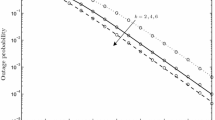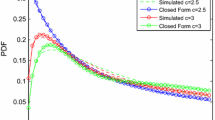Abstract
Energy adaptation for Asynchronous CDMA (A-CDMA) systems over Rayleigh and Rician fading distributions with and without diversity combining techniques has been discussed in literature. In this work, adaptive power control for A-CDMA systems over channels undergoing K-distribution is discussed in detail. K-distribution is a valid model to represent the envelope statistics of the backscattered echo, and is used to simulate the effects of a dense urban environment with the average received power level fluctuating slowly due to shadowing effects. Performance measures, such as probability density and cumulative distribution functions of (a) probability of error and (b) signal energy-to-noise ratio and, system parameters, such as fading margin, mean transmitter energy gain, and percentage points are computed for K-distribution channels as a function of probability of error specification and the probability of unsatisfactory operation.








Similar content being viewed by others
References
Sklar, B. (2001). Digital communications: Fundamentals and applications (2nd ed.). Upper Saddle River, NJ: Prentice Hall Inc.
Duman, T. M., & Ghrayeb, A. (2007). Coding for MIMO communication systems. Chichester: Wiley.
Rappaport, T. S. (1996). Wireless communications: Principles and practice (2nd ed.). Upper Saddle River, NJ: Prentice Hall Inc.
Garg, V. K., Smolik, K., & Wilkes, J. E. (1997). Applications of CDMA in wireless personal communications. Upper Saddle River, NJ: Prentice Hall Inc.
Mosa, A., & Abu, R. (2007). Introduction to CDMA wireless communications (1st ed.). Los Angeles, CA: Elsevier.
Bhaskar, V., & Joiner, L. (2005). Variable energy adaptation for asynchronous CDMA communications over slowly fading channels. Elsevier Journal of Computers and Electrical Engineering, 31(1), 33–55.
Khangura, S. K., Kaur, K., & Uppal, R. S. (2010). Power control algorithms in wireless communications. International Journal of Computer Applications, 1(12), 82–87.
Flemming, H., & Meno Finn, I. (1977). Mobile fading-Rayleigh and lognormal superimposed. IEEE Transactions on Vehicular Technology, 26(4), 332–335.
Kang, M., Yang, L., & Alouini, M. S. (2006). Outage probability of MIMO optimum combining in presence of unbalanced co-channel interferers and noise. IEEE Transactions on Wireless Communications, 5(7), 1661–1668.
Abdi, A. (1998). K distribution: An appropriate substitute for Rayleigh-lognormal distribution in fading-shadowing wireless channels. Electronic Letters, 34(9), 851–852.
Bithas, P. S., Sagias, N. C., Mathiopoulos, P. T., Karagiannidis, G. K., & Rontogiannis, A. A. (2006). On the performance analysis of digital communications over generalized-K fading channels. IEEE Communication Letters, 10(5), 353–355.
Modest, M. F., Levin, D. A., & Bansal, A. (2009). Correlated-K distribution method for atomic radiation in hypersonic non-equilibrium flows. 47th American Institute of Aeronautics (AIAA) Aerospace Sciences Meeting and Exhibit (pp. 5–8). Orlando, FL.
Bohge, M., Wolisz, A., Furuskar, A., & Lundevall, M. (2008). Multiuser OFDM system performance subject to control channel reliability in a multi-cell environment. IEEE International Conference on Communications (pp. 3647–3652). Beijing.
Shankar, P. M. (2004). Error-rates in generalized shadowed fading channels. Wireless Personal Communications, 28(3), 233–238.
Papoulis, A., & Pillai, S. U. (2002). Probability, random variables and stochastic processes (4th ed.). NewYork, NY: Tata McGraw-Hill Inc.
Author information
Authors and Affiliations
Corresponding author
Rights and permissions
About this article
Cite this article
Bhaskar, V., Gouthami Reddy, E. Adaptive Power Control for A-CDMA Systems Over K-Distributed Fading Channels. Wireless Pers Commun 90, 1843–1857 (2016). https://doi.org/10.1007/s11277-016-3426-2
Published:
Issue Date:
DOI: https://doi.org/10.1007/s11277-016-3426-2




